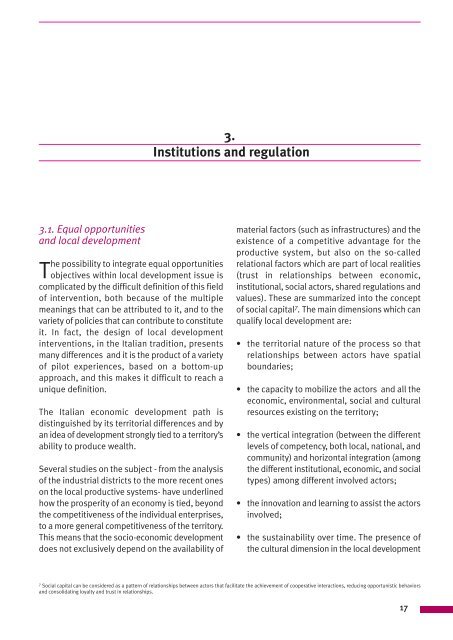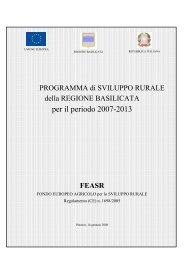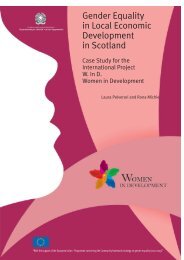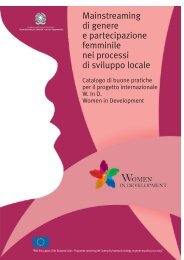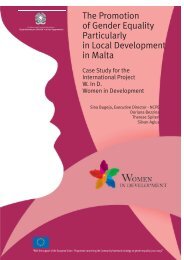3.Institutions and regulation3.1. Equal opportunitiesand local development<strong>The</strong> possibility to integrate equal opportunitiesobjectives <strong>within</strong> local development issue iscomplicated by the difficult definition <strong>of</strong> this field<strong>of</strong> intervention, both because <strong>of</strong> the multiplemeanings that can be attributed to it, and to thevariety <strong>of</strong> policies that can contribute to constituteit. In fact, the design <strong>of</strong> local developmentinterventions, in the Italian tradition, presentsmany differences and it is the product <strong>of</strong> a variety<strong>of</strong> pilot experiences, based on a bottom-upapproach, and this makes it difficult to reach aunique definition.<strong>The</strong> Italian economic development path isdistinguished by its territorial differences and byan idea <strong>of</strong> development strongly tied to a territory’sability to produce wealth.Several studies on the subject - from the analysis<strong>of</strong> the industrial districts to the more recent oneson the local productive systems- have underlinedhow the prosperity <strong>of</strong> an economy is tied, beyondthe competitiveness <strong>of</strong> the individual enterprises,to a more general competitiveness <strong>of</strong> the territory.This means that the socio-economic developmentdoes not exclusively depend on the availability <strong>of</strong>material factors (such as infrastructures) and theexistence <strong>of</strong> a competitive advantage for theproductive system, but also on the so-calledrelational factors which are part <strong>of</strong> local realities(trust in relationships between economic,institutional, social actors, shared regulations andvalues). <strong>The</strong>se are summarized into the concept<strong>of</strong> social capital 7 . <strong>The</strong> main dimensions which canqualify local development are:• the territorial nature <strong>of</strong> the process so thatrelationships between actors have spatialboundaries;• the capacity to mobilize the actors and all theeconomic, environmental, social and culturalresources existing on the territory;• the vertical integration (between the differentlevels <strong>of</strong> competency, both local, national, andcommunity) and horizontal integration (amongthe different institutional, economic, and socialtypes) among different involved actors;• the innovation and learning to assist the actorsinvolved;• the sustainability over time. <strong>The</strong> presence <strong>of</strong>the cultural dimension in the local development7 Social capital can be considered as a pattern <strong>of</strong> relationships between actors that facilitate the achievement <strong>of</strong> cooperative interactions, reducing opportunistic behaviorsand consolidating loyalty and trust in relationships.17
<strong>The</strong> promotion <strong>of</strong> gender equality <strong>within</strong> local development processes: Italyprocesses, in fact, requires more time foradapting to change.In practice, it is obviously more likely that a singlemeasure can only activate one <strong>of</strong> these variousdimensions, and that local development issustained by a number <strong>of</strong> actions and interventions,each one “belonging” to different areas <strong>of</strong>policy that can be activated at local level 8 .<strong>The</strong> previous considerations allow us tounderstand what might be improperly defined asthe Italian approach to the integration <strong>of</strong> equalopportunities in local development processes,starting from an analysis <strong>of</strong> the tools and the mainpolicies that “intercept” the local developmentprocesses.Following such considerations, in Italy variouslocal development support tools have beendeveloped beginning with those activated in thenineties in the area <strong>of</strong> national policies for the socalleddepressed areas <strong>of</strong> the country and, alonggeneral lines, in the field <strong>of</strong> national regional policy(that is, the whole <strong>of</strong> public measures aimed atguaranteeing development and competitivenessin specific territories with economic and socialimbalances), and arriving at the integratedterritorial planning as an implementation tool forthe Community Cohesion Policy for 2000 - 2006.At the same time, a well-developed regulatorysystem was developed to protect equality and tosupport and foster equal opportunities policies:it provides the bases and useful tools to promotegender oriented integration in local developmentinitiatives and to support female participation inthe definition and implementation <strong>of</strong> theinterventions.Staring from the principle <strong>of</strong> equal opportunitiesbetween women and man stated by the italianConstitution, the evolution <strong>of</strong> the Italian legislativesystem is the consequence <strong>of</strong> the several changesthat have taken place in the country over femaleissues. It has gone from regulations aimed atremoving legal obstacles to the principle <strong>of</strong>gender equality, to the definition <strong>of</strong> the existing“gender policies” to promote the full and effectiveparticipation <strong>of</strong> women in political, social andeconomic life. <strong>The</strong> institutionalisation <strong>of</strong> equalopportunities process during the nineties, hasalso led to the creation 9 <strong>of</strong> many bodies in thedifferent “fields” <strong>of</strong> equal opportunities, <strong>of</strong>tencreated ad hoc by the Italian government toanswer to the international and communitypressure and that have been slowly assimilatedinto the country’s government structures.Despite this, one <strong>of</strong> the distinctive features <strong>of</strong> thecountry, is the persistence <strong>of</strong> considerable gapbetween the presence <strong>of</strong> rich and progressiveregulations in the field <strong>of</strong> equal opportunities andthe real status <strong>of</strong> women in Italy - as pr<strong>of</strong>iled inthe previous chapter - especially in the gendercomposition <strong>of</strong> the different political andinstitutional levels and the quantity and quality<strong>of</strong> the female presence in the economic andproductive life <strong>of</strong> the country.<strong>The</strong> current process <strong>of</strong> institutional decentralization,especially with reference to the reform<strong>of</strong> the Title V <strong>of</strong> the Italian Constitution, has helpedto define a governance model <strong>of</strong> development andgender policies focusing more and more on a locallevel. With the proclamation <strong>of</strong> the Law forconstitutional change number 3 <strong>of</strong> 2001, theopportunity for Region to manage the economicsystem was amplified, having their legislativeauthority on the great part <strong>of</strong> the territorialsystems governing issues. <strong>The</strong> subsidiarityprinciple, reaffirmed by the new constitutional8 IRS (Institute for Social Research) “<strong>The</strong> transversal priorities in the 2000-2006 programming analyzed with respect to gender: the experience <strong>of</strong> the Autonomous Province<strong>of</strong> Bolzano”, Franco Angeli 2004.9 Edited by Isabella Rauti, “Percorsi di parità”, Ufficio Nazionale Consigliera di Parità - ISFOL 2005.18


